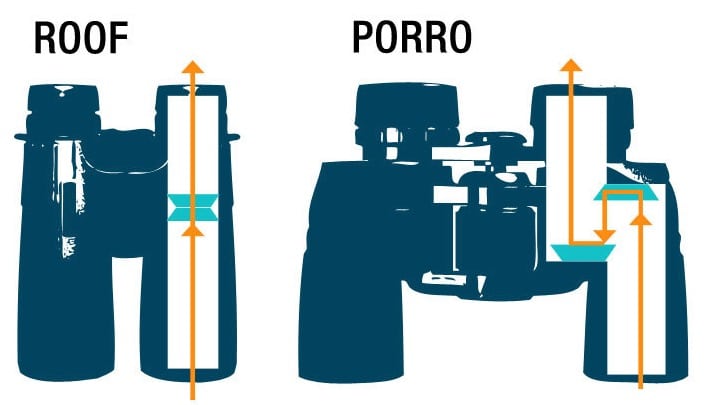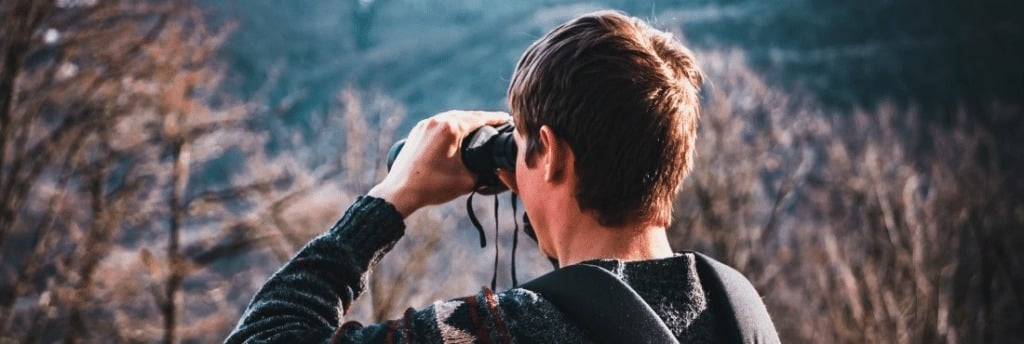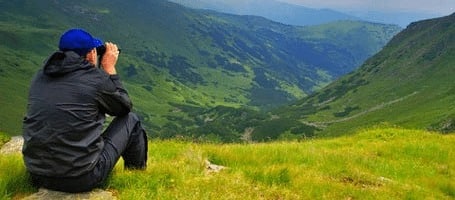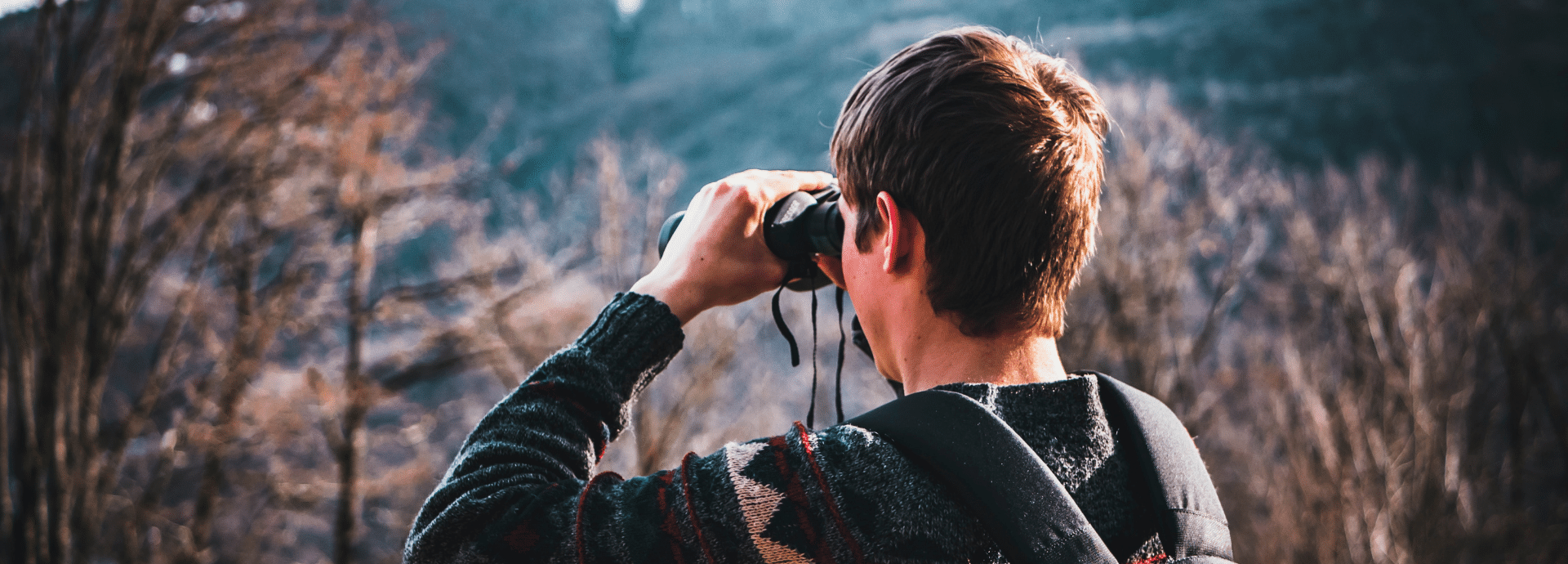Good binoculars are indispensable if you like to enjoy all the beauty that nature offers us outside. The goal of a viewer is to bring you closer to the object you want to look at. Before you proceed with the purchase, it is important to consider what you want to use the binoculars for, in short, what is your need and which binocular best suits your needs. Because there is no binocular that is suitable for all purposes, there are a huge number of models.
The construction and differences of binoculars
A binocular consists of:
- A Objective lens. This is the lens that faces the object, so it is not held against the eye.
- An ocular. The word ocular comes from the principle that this is the lens that faces the eye (the oculus). So that part where your eye is against.
Binoculars can be divided into monocular viewers, with which you only see with one eye, and binocular models, which are equipped with two prisms.
The binocular binoculars group can be divided into two types of binoculars
- Roof prism and
- Porro prism.
Roof prism
The roof viewer is slimmer because the light is sent through the viewer in a linear way. This ensures a more compact whole, but is often slightly more expensive due to the more complex prism system. This model transmits less light using the same lenses.
Porro prism
The porro viewer is a broader model because the image is transported via an N-shape.
This has the advantage that there is less light loss and the image has more depth.

Magnification and Obtical diameter
The description of a model always contains 2 numbers, eg 8×25.
The first number is the magnification factor. So in this case the object is magnified 8x.
If you look at a deer at a distance of 100 meters with binoculars with a magnification of 8, the animal will appear only 12.5 meters away from you. If you use a binocular with the magnification 10, the deer will be 10 meters away from you. Not a big difference.
If you are looking for a good all-round binocular, a copy with magnification 8. The greater the magnification, the more difficult it is to obtain or maintain a stable image, regardless of the diameter of the lens! A magnification of 10x is well suited for an advanced user. A tripod is already recommended at a magnification factor of 12x.
Which magnification is suitable for which purpose:
- Low magnification (4x-6x), used for sporting events, concerts, theater
- Medium magnification (7x-10x), used for universal use, hunting, bird watching
- High magnification (10x or more), used for distant objects, astronomy, aircraft spotting.
Object diameter
The second number refers to the diameter of the lens. The larger the lens, the more light it enters, so a larger lens provides a sharper and clearer image with more details. Ideal in situations where the lighting conditions are not optimal, such as a dark forest or spotting animals during twilight time. The term diameter objectives is also referred to as effective opening of the front lens. The objective diameter, expressed in millimeters, determines the size and weight of your binoculars. If you look at a viewer with a large diameter, it will weigh more and take up more space in your backpack, for example.
Which objective diameter to use for which purpose:
– Less than 40mm, for situations with plenty of light
– 40-50mm, used for medium light
– Over 50mm, for dim lighting and distant objects.
The further the image is enlarged, the smaller the field of view becomes. So you only see a very small part of what is going on in front of you.

Quality of the glass of the lens
Furthermore, a distinction can be made in the quality of the glass from which the lenses are made, with BAK 4 being the better type and BAK 7 the slightly lesser. However, the difference in quality of the glass can be offset by the coating, which is applied to the lenses (and to the prisms) with any good binocular. This coating is necessary to transport the light as well as possible without causing image or color disturbance and to protect the lenses. Of course – depending on the price level – there are several options.
- single layer (Fully coated)
- multi-layer (Multi coated)
- multi-layer on several lenses (Fully Multi coated) coating
There is also the Phase coating, which can be found on the more luxurious roof viewers. However, this coating is not on the lenses but on the prisms!
Waterproofing
The water resistance of a binocular is also something to consider. Some binoculars are not waterproof at all, other models are neatly closed with rubber rings. Some of these binoculars are also filled with Nitrogas (Nitrogen), so that they can no longer fog up internally. The advantage of gas-filled is not only the watertightness, but also the dustproofness.
Exit pupil
When you look at binoculars at arm’s distance, a circle can be seen in the eyepiece lenses. This is the exit pupil. The shape of the exit pupil is a good indication of lens quality. If the shape is perfectly round, you can rely on high-quality lenses. The size of the light circle can be calculated by dividing the objective diameter by the magnification.
With an 8×40 binoculars, the exit pupil is therefore 5 mm. The higher the number, the more light.
In young people, the pupil of the human eye can open up to about 7mm in the dark, in bright light the pupil closes up to about 2mm. As one gets older, the suppleness of the pupil will decrease, so that the pupil only opens up to about 5mm in the dark.
This shows that the purchase of a viewer with an exit pupil larger than 8mm provides no added value after all, the human eye cannot make use of the larger spot of light.

Adjust the binoculars properly
– Adjust eye cups:.
Do you wear glasses or not? Binoculars almost always have eye cups that can be turned in and out or folded. These caps ensure that the distance between the eye and the viewer is good. This is important because otherwise you will not have a full picture and will miss the clarity. If you wear glasses, you must screw in or fold in the eye cups. If you are not a spectacle wearer, they must be turned out, pulled out or folded.
– Set the correct width:
It is important to adjust the width of the viewer (more specifically the distance between the eyepieces) to match the distance between the eyes. You do this by moving both parts of the binoculars closer to each other or further apart. Look at an object at a great distance and adjust the width of the viewer so that both eyes separately have a full and round image. You should see exactly the same with both eyes.
– Diopter adjustment:
The dioptri setting is to compensate for any deviation between the power of the eyes.
The setting is usually on the right eyepiece, but sometimes also behind the central focus and sometimes you can adjust the diopter by pulling out the central focus button. Proceed as follows: Choose an object at a reasonable distance and focus with the central focus at the top for the left eye (keep the right eye closed, or better keep the hand in front of the right eyepiece). Then close the left eye or place your hand in front of the left eyepiece and focus the right eye with the diopter setting.
– Focus the viewer:
All you have to do now is focus on the object you want to see. Do this in such a way that you can see immediately. If you are slightly off, the eyes will try to compensate and you will sometimes see sharp, but this is tiring for the eyes.
The water resistance of a viewer is also something to consider. Some binoculars are not waterproof at all, other models are neatly closed with rubber rings. Some of these viewers are also filled with Nitrogas (Nitrogen), so that they can no longer fog up internally. The advantage of gas-filled is not only that the viewer is waterproof, but also dust-proof. Gas-filled prevents condensation …. “foggy” view.
From all those different models, we have a small selection of viewers that we think are suitable for the hiker who goes into nature.

